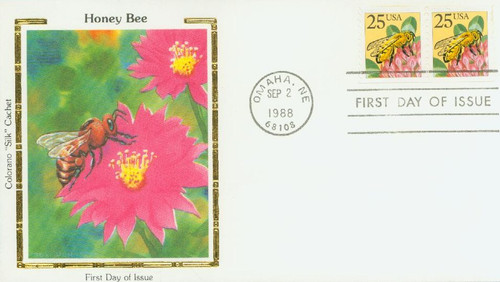
# 2281 FDC - 1988 25c Honeybee, coil
1988 25¢ Honeybee Coil Stamp
City: Omaha, NE
Quantity: 2,206,060,000
Printed By: Bureau of Engraving and Printing
Printing Method: Lithographed and engraved
Perforations: 10 vertically
Color: Multicolored
First U.S. Combination-Process Coil
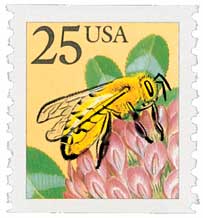
On September 2, 1988, the USPS issued its first coil stamp printed by two totally different procedures.
The stamp pictured a honeybee. Years earlier, in 1980, the USPS had issued a 15¢ stamped envelope picturing a honeybee with a pair of orange blossoms. However, the light color of the printing on the white envelope was barely visible and many bee enthusiasts were disappointed.
The 1988 definitive was the USPS’s chance to redeem themselves. And they did by making it a special issue. The stamp was the USPS’s first combination-process coil, printed by two different procedures at the Bureau of Engraving and Printing (BEP).
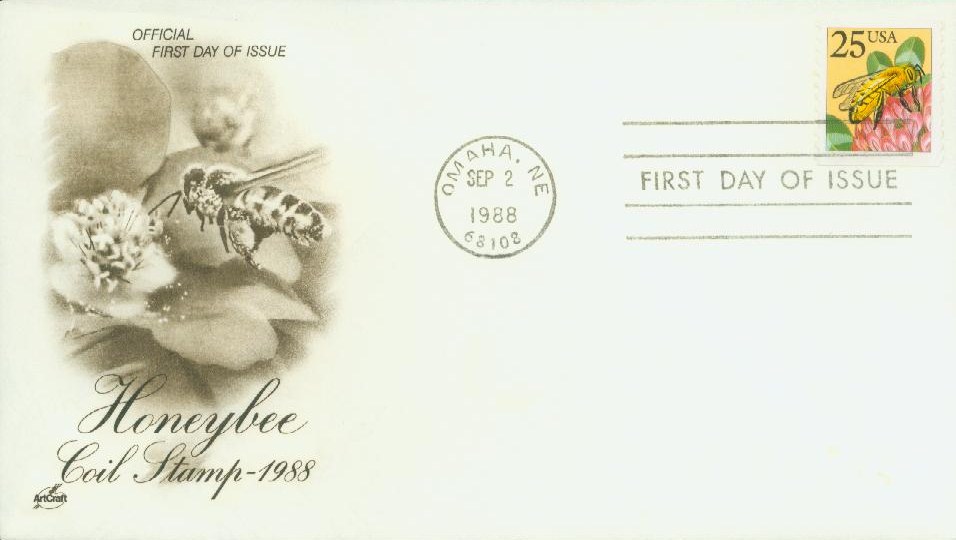
The stamp printing began on the BEP’s Goebel Optiforma press. This press printed all the color portions of the design. The stamp rolls were then taken to the C press, which printed the black intaglio and then applied the phosphorescent tagging. The stamps were then perforated and cut into coils for sale.
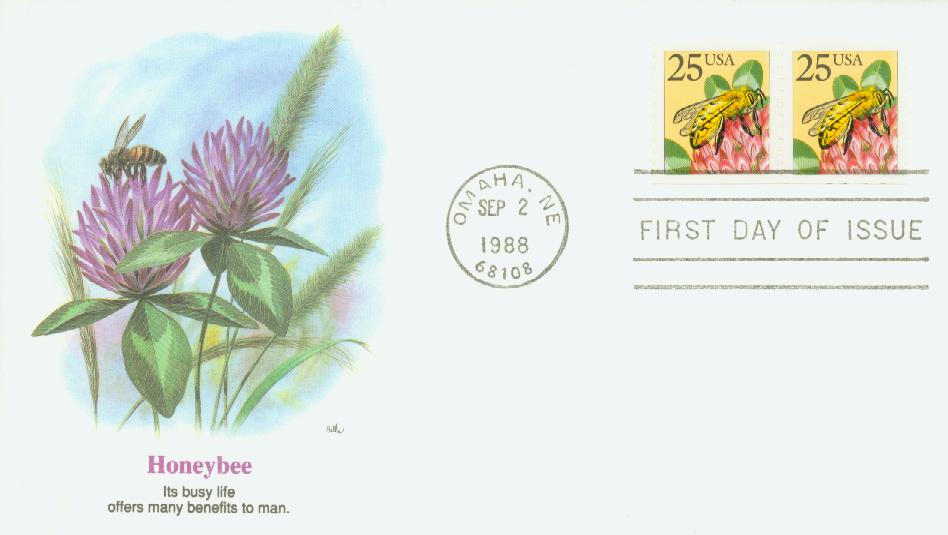
The USPS had already been using the D Press, which could do offset and intaglio printing as well as phosphor tagging all in one machine. But the bee stamp was the first coil printed using these multiple presses. Later issues of the stamp were also printed on the D Press.
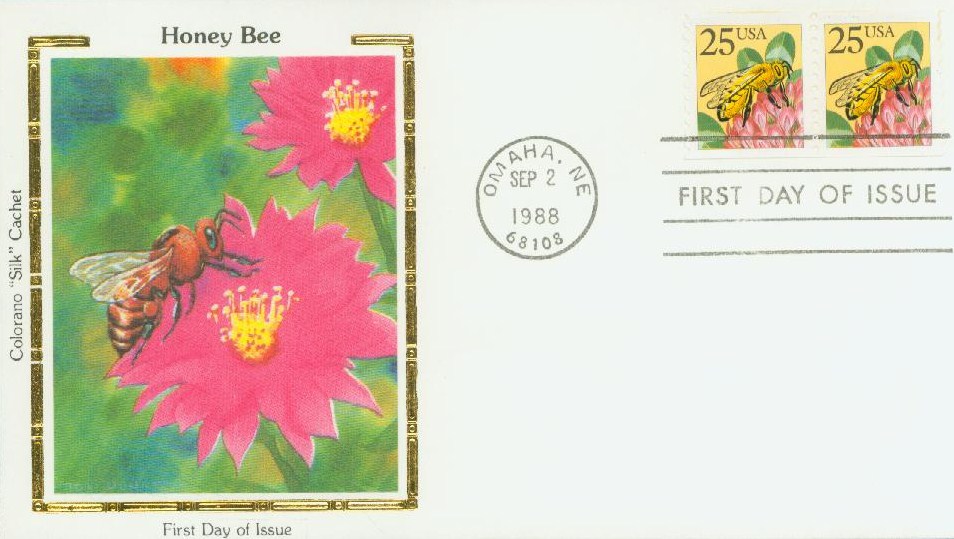
The stamp was first announced on April 4, with an issue date of June 11. However, later in April, the USPS announced that the issue would be delayed because they wanted to make sure they could produce the stamps properly in large numbers to meet demand.

Eventually, the stamps were issued on September 2, 1988, at the Omaha Stamp Show, in Omaha, Nebraska. The issue of these stamps was part of the opening ceremony for the show. After the first day ceremony, the postmaster general cut a strip of honeybee stamps to mark the official opening of the show.
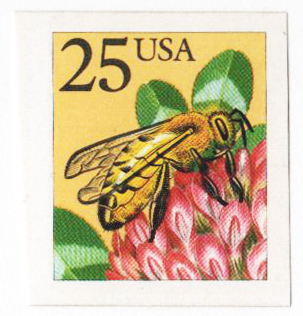
There was also a small controversy surrounding these stamps and the BEP. Normally the BEP would send a letter to its employees for a job well done. However, in this case, they produced about 80 souvenir cards for their employees that read, “In commemoration of those employees of the Bureau of Engraving and Printing, whose shear (sic) brilliance, dedication, steadfastness, innovativeness, and technical know-how made ‘Project Honeybee’ a success. The Bureau salutes you.”
1988 25¢ Honeybee Coil Stamp
City: Omaha, NE
Quantity: 2,206,060,000
Printed By: Bureau of Engraving and Printing
Printing Method: Lithographed and engraved
Perforations: 10 vertically
Color: Multicolored
First U.S. Combination-Process Coil

On September 2, 1988, the USPS issued its first coil stamp printed by two totally different procedures.
The stamp pictured a honeybee. Years earlier, in 1980, the USPS had issued a 15¢ stamped envelope picturing a honeybee with a pair of orange blossoms. However, the light color of the printing on the white envelope was barely visible and many bee enthusiasts were disappointed.
The 1988 definitive was the USPS’s chance to redeem themselves. And they did by making it a special issue. The stamp was the USPS’s first combination-process coil, printed by two different procedures at the Bureau of Engraving and Printing (BEP).

The stamp printing began on the BEP’s Goebel Optiforma press. This press printed all the color portions of the design. The stamp rolls were then taken to the C press, which printed the black intaglio and then applied the phosphorescent tagging. The stamps were then perforated and cut into coils for sale.

The USPS had already been using the D Press, which could do offset and intaglio printing as well as phosphor tagging all in one machine. But the bee stamp was the first coil printed using these multiple presses. Later issues of the stamp were also printed on the D Press.

The stamp was first announced on April 4, with an issue date of June 11. However, later in April, the USPS announced that the issue would be delayed because they wanted to make sure they could produce the stamps properly in large numbers to meet demand.

Eventually, the stamps were issued on September 2, 1988, at the Omaha Stamp Show, in Omaha, Nebraska. The issue of these stamps was part of the opening ceremony for the show. After the first day ceremony, the postmaster general cut a strip of honeybee stamps to mark the official opening of the show.

There was also a small controversy surrounding these stamps and the BEP. Normally the BEP would send a letter to its employees for a job well done. However, in this case, they produced about 80 souvenir cards for their employees that read, “In commemoration of those employees of the Bureau of Engraving and Printing, whose shear (sic) brilliance, dedication, steadfastness, innovativeness, and technical know-how made ‘Project Honeybee’ a success. The Bureau salutes you.”

